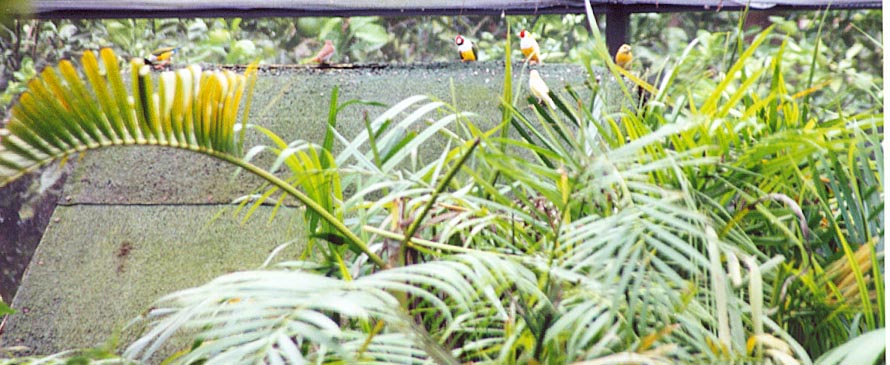|
|
. WE OFFER A MAIL ORDER SERVICE , WHICH MEANS YOU CAN MAIL YOUR ORDER IN TO US WITH YOUR PAYMENT AND WE WILL U.P S. YOUR ORDER TO YOU. ONLY IF YOUR LOCAL DEALER DOES NOT CARRY THE ABBA PRODUCTS LINE |
|||||||
 |
|||||||
 |
|||||||
|
|
||||||||||||||||||||||||||||||||||||||||||||||||||||
|
|
SORRY BUT WE CAN NO LONGER SHIP TO P.O. BOXES |
|
ONCE YOUR ORDER IS PLACED ONLINE YOU CAN NOT MAKE CHANGES OR ADD ON |
|
DUE TO THE SURCHARGES BY UPS AND THE RISING COST OF RAW MATERIALS 50 LBS BAGS WILL NOW BE 47 LBS BAGS. SORRY FOR THE INCONVENIENT |
|||||||
|
*WE WILL BE CLOSED JUNE 20TH TO 23RD.* ORDERS WILL BE SHIPPED WHEN WE RETURN. |
|||||||
 |
|||||||
|
My Experience with Gouldian Finches For over 60 years I have been breeding many species of birds, such as Canaries, Gouldians, European Finches, South American Finches, and many others, along with one of my preferred which is the Venezuelan Black Hooded Red Siskin. However, prior to The Abba Cage Bird Diets which came into existence in the early 50's, I had a difficult time in keeping the Gouldians alive; never mind breeding them. I would like to mention to you that a few times I also imported some Gouldians from Japan. Along with the Gouldian shipment I received a generous amount of special seed to assure the continuation of a so-called healthy diet. Despite all the best food that I was buying and plus the improved food from Japan it would not keep the birds alive longer than a week to ten days. They simply looked beautiful in the morning and dropped dead by the afternoon. I repeat I tried to purchase the best seed diet money can buy but the birds still died. In those days I was not the only one who couldn't keep Gouldians alive, many other breeders that I became acquainted with were having the same problems. Over the years I began to experiment with various concoctions of seed formulations and by adding proteins, vitamins and minerals I came up with good wholesome diets. At last I finally conquered the problems I was having and I was able to keep the Gouldians alive! Eventually, bingo, they bred for me. As time went by other breeders of Gouldian Finches who used my method of feeding were also successful! However, many of them indicated to me that they harvest the eggs from the Gouldians and placed them under the Society Finches to raise them. Many breeders today still use the foster parent method of breeding. As for myself, I believe this is a lot of work and I don't have time to foster babies. However, to each his own. I have nothing against anyone going through the trouble of foster parenting. I repeat, I personally like all species of birds to raise their own youngsters. I never intentionally fostered out any bird that I bred, except in a situation when an injury or ailments incapacitated the mother. If I did foster parent any babies it was temporary. When the original parents got better I would let them have their own babies back. Some years ago I built a double breeding English style box cage for a pair of Gouldians. I also built a wood nest box that I attached to the right side of the cage. Guess what, I forgot to put an access door to the nest box. To make a long story short, I placed a pair of Gouldians in that large double breeding cage and I said to myself one day I will take the box out and put a door on it. Well, I never did put the door on and the nest box remained inaccessible. In other words I was not able to look inside. However, a couple of months later, to my surprise, six juvenile Gouldians came out of the nest box. WOW, what a surprise! At that time I convinced myself that you don't really need foster parents to raise Gouldians. My first pair of Gouldians fed their own babies beautifully. Full of excitement I called my friend, Ramon, and I said, "Guess what my friend, my pair of Gouldians produced six babies; they just came out of the nest box!" He immediately replied, "Mine too. I have five babies and they fed their own too. I took your advice to leave them alone to see what happens. I am so happy that I got five babies!" About ten years ago I built a large aviary, which measure approximately 45 x 65 x 10ft high, at my residence in the southwestern part of Florida. Besides other species of birds I purchased two pairs of Gouldians from a customer of Abba. I bought them during a cold spell in the winter months. I explained to the man where I was going to put the birds and he said to me, "Oh, oh, you are not going to put my birds in the cold outdoor aviary. You must wait until the spring." I said, don't worry, I don't want to jeopardize the health and welfare of these beautiful birds. I know what I am doing." To make a long story short, the daytime temperature was about 45 degrees. I assume much colder during the night. I released the birds in the aviary at about ll: 00 in the morning. They survived the next night beautifully and they are still living as of May 1999 and still producing? From the original two pairs now, as of May 1999, I assume there will be at least eight breeding pairs. Over the years the youngsters that were produced have been removed from the aviary in juvenile plumage; however, some of them have been left in the aviary. So, therefore, the number of pairs were increased so the production of the youngsters was also increased yearly; from 18-20 the first couple of years to over a 100 in 1998-1999. On April 9th, 10th, 11th, 12th, 13th, 14th and 15th, 1999, I removed a total of 117 immature youngsters consisting of lots of yellows, mutations, white chests, normals, black heads, as well as red and yellow heads. I had to leave a few youngsters behind in the aviary because the juvenile spots were still present around the beak. Nevertheless, on April 15th, I cleaned, washed, sterilized and sprayed all the nest boxes, nine of them, for parasites! I always have in the aviary plenty of nest boxes and nest sites, plus plenty of nesting material consisting of dry grasses, coconut fibers, plus other natural fibers. If the Gouldians want to produce more youngsters for me in 1999 it is up to them. I will graciously accept the additional baby Gouldians. I feed all the birds in the aviary Abba 1900 Complete Exotic Finch Diet. In one part of the aviary there is sort of a small garden pavilion that protects the birdseed and other food from getting wet by the rain. Under the same pavilion I have a large seed hopper that accommodates about 75 pounds of Abba l900 Complete Exotic Finch Diet and a small hopper that accommodates about 10 pounds of Abba Green 92A Complete Nestling Food for all seed eating birds. Another small seed hopper contains about five pounds of Abba Mineral. The seed and other food supply is checked every month. Sometimes I don't put any additional seed for three or four months. It all depends on the number of the birds in the aviary. However, at least two or three times a year I turn all the seed and food hoppers upside down and totally wash and sterilize them. Also in the aviary there is a sprinkler system that goes on every other day for irrigation and also supplies fresh water to a small fish pond which is 10ft x 10ft about 12" deep with a lot of ornamental rocks and a waterfall. All the birds love that situation; they feel they are in the York Peninsula of Australia. They're happy, colorful, beautiful, healthy, and it's a pleasure to look at them. The entire aviary, except the fishpond, is natural earth. Inside the aviary there are trees growing, such as miniature palm, wild cherry, orange and other trees that I don't know the name, plus all sorts of vegetation that gives a tropical luscious green look throughout the aviary. Also in the aviary there are wild grasses and vegetables planted and they grow all year round. All birds benefit from the seeding head, seeding grass and the vegetables. When I'm in Florida and I have a chance, I pick up a couple handfuls of seed and I sow them on the ground. (Remember, the birds in the wild state eat the seed in either a milky stage or fallen on the ground which are softened by the rain and moisture). Abba 1900 Complete Exotic Finch Diet is the closest diet that mother nature provides the birds in their wild habitat; therefore the bird fanciers can rest assure that by feeding their birds the Abba 1900 Complete Exotic Finch he/she are feeding their birds a complete wholesome diet. Most of the ingredients in the Abba 1900 Complete Exotic Finch Diet are similar foods which finches find in their wild habitat. |
|||||||


